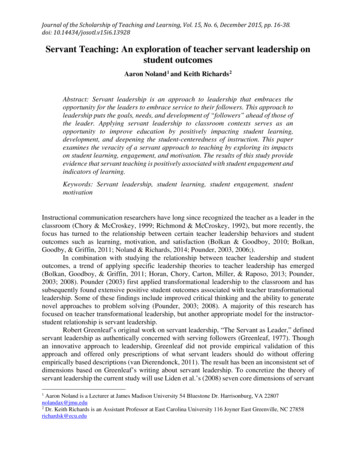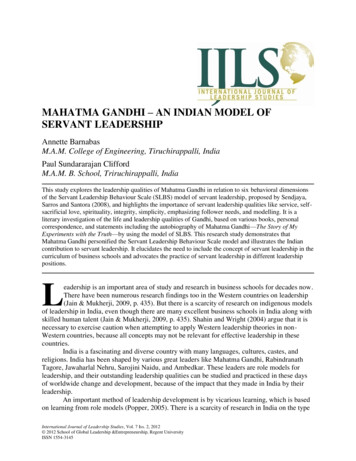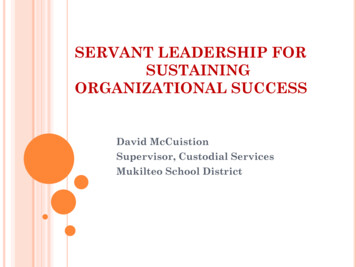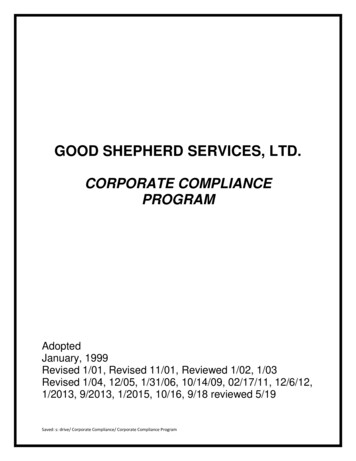
Transcription
HTS Teologiese Studies/Theological StudiesISSN: (Online) 2072-8050, (Print) 0259-9422Page 1 of 8Original ResearchServant leadership and shepherd leadership:The missing dynamic in pastoral integrity inSouth Africa todayAuthor:Kelebogile T. Resane1Affiliation:1Department of Historicaland Constructive Theology,Faculty of Theologyand Religion, University ofthe Free State, Bloemfontein,South AfricaCorresponding author:Kelebogile Resane,resanekt@ufs.ac.zaDates:Received: 10 June 2019Accepted: 24 Jan. 2020Published: 12 Mar. 2020How to cite this article:Resane, K.T., 2020, ‘Servantleadership and shepherdleadership: The missingdynamic in pastoral integrityin South Africa today’,HTS Teologiese Studies/Theological Studies 76(1),a5608. https://doi.org/ 10.4102/hts.v76i1.5608Copyright: 2020. The Authors.Licensee: AOSIS. This workis licensed under theCreative CommonsAttribution License.This article aims to give a full definition of servant leadership and shepherd leadership bycomparing and contrasting the two texts of Jeremiah 23 and John 10. The notion of ‘shepherd’or ‘shepherding’ is analysed and brought into the current debate on servant leadership. Theshepherd metaphor used in the two passages is contextualised to the South African pastoralleadership situation, especially with regard to pastoral integrity. The status of pastoralleadership in the South African church community is highlighted as a challenge to beconsidered from the perspective of servant leadership proposed in Matthew 20:16. Thepresenter would like to conscientise the Christian community that integrity in the areas ofcaring, feeding and protecting the flock should be a driving force towards pastoral integrity.The exegetical findings of the shepherd model are applied to the pastoral leadershipintegrity. An appeal is made to the ecclesiastical community to return to the fundamentalsof leadership by embracing servant leadership as an ensuing model for pastoral leadershipintegrity. The article contributes towards the knowledge of the definition, role andunderstanding of pastoral leadership defined through servant and shepherd leadershipconcepts. Its academic value lies in the fields of church leaderships, ethics and biblicalteachings.Keywords: servant; shepherd; leader; pastor; church; integrity.IntroductionThis article defines the concepts of servant leadership and shepherd leadership; it aims to explainhow these two leadership concepts express leadership in the church, especially for those inpastoral leadership. The three texts of Jeremiah 23, John 10 and Matthew 20:16 are briefly surveyedto define these two leadership concepts. It has to be borne in mind that there is currently notheological in-depth analysis of these concepts, except gleaning from the fields of psychology andsociology, with a little bit of contribution from practical theology. It is broadly accepted thattheology cannot be a mere observer of developments in other disciplines, especially in humanities,without formulating its own theoretical frameworks in and through which to conduct itsarguments and insulate key ideas from these external sceptics and mystics (Lovin et al. 2017:xxi).This gives this article the authenticity of interdisciplinarity and shows how social sciences aresymbiotically related to expose the truth that supports or enhances metanarratives.Pastoral leadership in South Africa is, in many instances, marred by integrity crises.Proposal brought forth is the warning against materialism, lack of credibility in reporting, prideand shallow theological training.These could be addressed with credible pastoral theology that emphasises pastoral ethics, whichfocus on training that does not separate the academic from the practical exposure and experience.This is in agreement with Chiroma (2017) that:Ministerial development is to be holistic, including the personal, spiritual, academic and social developmentof students. Effective ministry requires not only abstract theological and biblical knowledge, but also acertain level of ministerial competencies (e.g. the articulation of theological reflection and learning thepractice of ministry, the transition from formal theological training into the work of ministry). (p. 51)Read online:Scan this QRcode with yoursmart phone ormobile deviceto read online.The curriculum for ministerial training and formation is challenged to take a new turnwhere morality and integrity form an irrefutable salience in the development of servant andshepherd leaders.http://www.hts.org.zaOpen Access
Page 2 of 8Definitions of termsServant leadershipServant leadership is a timeless leadership philosophy with itsmain focus on a leader as a servant whose purpose is to serve.The servant leadership philosophy and practices have beenexpressed in many ways and applied in many contexts. Someof the most well-known advocates of servant leadershipphilosophy include Blanchard (2003, 2007) Stephen Covey,Merrill & Merrill (1995), Senge (1990), Peck (2004), Wheatley(2002), McGee-Cooper, Welch and Trammell (2015), Spears(2010:16) and Keith (2015) from the Greenleaf Center forServant Leadership. The phrase ‘servant leadership’ wascoined by Robert K. Greenleaf in The Servant as Leader, an essaythat he first published in 1970. In that essay, Greenleaf said:The servant-leader is servant first It begins with the naturalfeeling that one wants to serve, to serve first. Then consciouschoice brings one to aspire to lead. That person is sharplydifferent from one who is leader first, perhaps because of theneed to assuage an unusual power drive or to acquire materialpossessions The leader-first and the servant-first are twoextreme types. Between them there are shadings and blends thatare part of the infinite variety of human nature.Quite a good number of authors mentioned above areassociated with Greenleaf Center for Servant Leadershipbased in Indianapolis, IN, USA. For instance, in his works,Greenleaf discusses the need for a better approach toleadership, one that puts serving others – includingemployees, customers and the community – as the numberone priority. Servant leadership emphasises increased serviceto others, a holistic approach to work, promoting a sense ofcommunity and the sharing of power in decision-making(Spears 2005:2). Spears (2005) continues to highlight that inall of Greenleaf’s writings, there are 10 characteristics of theservant-leader that are of critical importance and are centralto the development of servant-leaders. Without anyelaboration on each of them, these characteristics are:listening, sympathy, healing, awareness, persuasion,conceptualisation, foresight, stewardship, commitment tothe growth of people and building of the community(Spears 2005:3–4). One exponent of servant leadership isWong (2007), who continued the notion as follows:In sum, different from the traditional trait, behavioral, situational,and contingency leadership models, SL focuses on (a) the humbleand ethical use of power as a servant leader, (b) cultivatinga genuine relationship between leaders and followers, and(c) creating a supportive and positive work environment. However,in terms of the actual exercise of leadership, servant leaders arefree to incorporate the positive aspects of all other leadershipmodels except command-and-control dictatorship. (p. 3)Original Researchon the growth and the well-being of people and thecommunities to which they belong. Whilst traditionalleadership generally involves the accumulation and exerciseof power by one at the ‘top of the pyramid’, servant leadershipis different. The servant-leader shares power, places theneeds of others first and helps people develop and performas efficiently as possible.In his second major essay, The Institution as Servant, Greenleafarticulated what is often called the ‘credo’. There he said thefollowing (Spears 2004):This is my thesis: caring for persons, the more able and the lessable serving each other, is the rock upon which a good society isbuilt. Whereas, until recently, caring was largely person toperson, now most of it is mediated through institutions – oftenlarge, complex, powerful, impersonal; not always competent;sometimes corrupt. If a better society is to be built, one that ismore just and more loving, one that provides greater creativeopportunity for its people, then the most open course is to raiseboth the capacity to serve and the very performance as servantof existing major institutions by new regenerative forcesoperating within them. (p. 7)Servant leadership is easy for people with high self-esteem.Such people have no problem giving credit to others.They have no problem listening to other people for ideas.They have no problem in nurturing other people towardsmaturity and competency. They do not think that building upother people is going to be threatening in any way (Blanchard1999:2). For them, empowering other people is a goal, forthey know that once ‘the conditions of empowerment are inplace, servant leadership creates powerful results’ (Covey,Merril & Merril 1995:251). In a nutshell, servant leadership isa process of influencing others to confront reality and movetowards a shared vision, whereby the interests of people andtheir common good are prioritised over the personal interestsof the leader (Ebener 2010).Shepherd leadershipShepherd leadership is sending others to the front to take thelead in areas where they are the strongest. It is both a qualityand the action of deliberate efforts to develop others. It is aleadership sense of responsibility entrusted by God to mapout the way for a brighter and better future for the emergingleaders. The welfare of the sheep (those led) becomes apriority. The present author (Resane 2014) mentionedsomewhere the following:The bottom line of this servant-first is to ensure that otherpeople’s highest priority needs are being served.[A] shepherd refers to a keeper of sheep. This is the person whotends, feeds, or guards the flocks. The Hebrew word forshepherding is often translated as ‘feeding’ as it is impressed bythe next statement, ‘I shall not want’ or ‘I shall lack nothing’ –alluding to the fact that the Psalmist means he will lack neither inthis life nor in the next. (p. 5)The ensuing passion of servant leadership is the growth ofthose being served. In this process of being served, themeasuring yardstick assesses how those being served growwiser, become freer, healthier and become the initiators ratherthan those commanded. A servant-leader focusses primarilyShepherd imagery appeared throughout the Bible beginningin Genesis (Stanley 1961), and according to Swalm (2010),shepherding occurred over 500 times across the OldTestament and the New Testament. The great Old Testamentleaders, Moses and David, were shepherds of both sheep andhttp://www.hts.org.zaOpen Access
Page 3 of 8God’s chosen people, whilst many of the Old Testamentprophets also used the shepherd imagery as they proclaimedtheir revelations.The shepherd metaphor reflects how leaders guide, protectand provide. Resane (2014) expanded this function as follows:The broader functions of the shepherd were to lead the sheep topastures and water (Ps 23:1) to protect them from wild animals(1 Sm 17:34–35); and to guard them at night, whether in the open(Lk 2:8) or in sheepfolds (Zph 2:6) where they counted them asthey entered the fold (Jr 33:13). They took care of the sheep andeven carried weak lambs in their arms (Is 40:11). (p. 2)This means that the shepherd-leader directs the flock in areasof conduct and actions. They assist or lead the flock.The shepherd teaches the flock for restoration purposes andguides them in paths of righteousness. They are protected fromerroneous dogma. Tenney (1975) highlighted this as follows:The life of the sheep was dependent upon the power andprovision of the shepherd. Their recognition of him and hisrecognition of them established the relationship. Hearing hisvoice, following his leading, entering the fold through him, andthe refusal to follow others was John’s picture of belief. (p. 165)Leaders in the church are called to be shepherds, not a board ofdirectors. This requires involvement in a personal shepherdingministry amongst the people. The shepherd leader unpacksthe four primary ministries of shepherds – knowing, feeding,leading and protecting – on macro (church-wide) and micro(personal) levels (Witmer 2010).The prophetic literature of the Old Testament refers tonational leaders as shepherds (Ezk 34:1; Jr 23:1).Passage from Jeremiah 23 issues judgement to shepherdswho have not upheld their duties to their flock. Jeremiah isnot concerned with the actual livestock and the realshepherds. Instead, the prophet is using a common metaphorfrom the ancient Near East to speak of human kings andleaders as shepherds to the people. The ovine imagery isappropriate as the duties and responsibilities of shepherdswould be well known to ancient readers.Shepherds are supposed to take care of their sheep – feedthem, protect them and guide them.When David confronted Goliath, he based his offer primarilyon the experience he had gained as a shepherd with lions andbears that preyed on the flock. Shepherding of those dayscalled for bravery, and the shepherd was responsible for thelivelihood of the flock. The legitimate shepherd would riskhis life for the protection of his flock of sheep. ‘The shepherdwillingly provides for the sheep green grass, safe and securewater, and a safe and protected path’ (Adamo 2018:2).Many pastors do not have intimate knowledge of thesepastoral responsibilities. The metaphor of a shepherd reallyworks only for those possessing prior biblical knowledge orhttp://www.hts.org.zaOriginal Researchlivestock lifestyle or experience. How might we reimaginethis metaphor for today? How do we speak of and imagineleadership? Similarly, many of us do not live under the ruleof a king. To conceive of God as a king does not resonate wellwith a people of democracy. We need perhaps new metaphorsfor leadership, a way to update and expand our biblicalmetaphors. But where shall we obtain these understandingsof leadership?Jeremiah 23 and John 10 narrativesexamined and comparedThe Jeremiah text shows that the scattering God is also thegathering God. Judgement is passed on the wicked politicaland religious leaders (kings and shepherds) because theyconsort and confer together for the scattering and thedestruction of God’s sheep (Jr 23:1–2), instead of offeringpastoral care expected from them. Wessels (2014) is correct that:In the Jeremiah text the metaphor of a shepherd is used to referto the leaders in the Judean society (Jr 3:15; 6:3; 10:21; 12:10; 22:22;23:1; 23:4; 25:34–36). The concept of a shepherd comes from thedomain of rustic life where a person is given the responsibility tolead sheep into pastures, to watch over them, to keep themtogether, to protect them and to bring them back to safety. (p. 2)The shepherds failed to attend to God’s people in care andprotection, so God will attend to them on judgement. Notonly that, in Jeremiah 23:3–4, God declared:Then I will gather the remnant of my flock out of all the countrieswhere I have driven them, and I will bring them back to theirfold, and they shall be fruitful and multiply. I will set shepherdsover them who will care for them, and they shall fear no more,nor be dismayed, neither shall any be missing, declares the Lord.The Lord will restore the fortunes of his people, and they willhave shepherds who care for them, provide for them andprotect them. How will these shepherds serve God’s people?The parallel passage in Jeremiah 3:15 tells us: And I will giveyou shepherds after my own heart, who will feed you with knowledgeand understanding.The fallible shepherds (Jr 23:1) will be replaced with credibleones that are divinely appointed to tend the re-gatheredsheep (Jr 23:4). The leaders of God’s regathered people willlead them by feeding them the knowledge and understandingof God’s ways and of the Word.Unlike the shepherds of Jeremiah 23, Jesus sets an oppositeexample of what a credible and genuine shepherd should be.The Gospel of John contributed not only unique perspectiveson Jesus, his deity and his ministry but also gave an insightinto the characteristics necessary to be effective disciples(DeSilva 2004:391). The good shepherd narrative of John10:1–18 offered unique insights on lessons in leadershipdirectly from Jesus. In fact, John 10 narrative is a Christocentrictheology of leadership. Jesus was the epitome of servantleadership, as demonstrated by shepherd-leadership in thisnarrative (Thompson 2007:117).Open Access
Page 4 of 8John’s Christology provided some unique contributions tothe ‘identity and significance of Jesus’ (DeSilva 2004:417),and the shepherd narrative depicted characteristics of a goodshepherd, the leader who protected, guided and cared for theflock. John was clear in presenting Jesus as the ‘goodshepherd’ in John 10 (Scott 1995) who was sacrificial andloving (Wright 2012). Jesus claimed that he was destined tolead the sheep out into new pastures. This, as per David’sPsalm 23, meant sustenance and refreshment of the humansoul (Tenney 1975:164). The prevalence of shepherding inScripture suggests that the several aspects of herding andcaring for sheep are useful for depicting proper relationshipsbetween Christ and his people, and that those characteristicscan similarly offer lessons in leadership (Tenney 1981).The panoramic view of these two texts (Jr 23 and Jn 10) makesone to conclude that the servant leader and shepherd leadershare the same characteristics of serving the sheep by lovingthem and developing a close and intimate relationship withthem, so that they know his voice and trust him. This leads toan understanding of the needs of the sheep and what threatensthem during their timid state of needs. Servant and shepherdleaders work tirelessly to provide for and protect the sheep byleading them to fresh pastures and fresh water. Generally, thisleader cares for, loves and sacrifices his life for them.The shepherds referred to in Jeremiah’s text were those whoJesus called thieves and robbers. Thieves are those who obtaintheir booty by subtlety, whilst robbers obtain their loot byviolence. Thieves come to satisfy their own fleshly desires(Hobbs 1979:50). From Jesus’ perspective, these are the falsemessiahs, false prophets and false teachers.Pastoral integrityIntegrity speaks of wholeness, entireness or completeness.The word ‘integrity’ is derived from the root, integer, whichmeans untouched, intact or entire. Dividedness is notcompatible with integrity. A person with integrity isnot divided (duplicity) or pretending (hypocrisy). His or herwhole life operates in synchrony. He or she is whole and hisor her life is put together. All aspects of his or her life worktogether harmoniously (Wiersbe 1991:21).Pastoral integrity implies transparency – nothing to hide andnothing to fear. The ethical pastor’s life is an open book. He isinteger. The person with integrity has a single will thatis seeking nothing but to serve others.Like the shepherds referred to in Jeremiah 23, many pastorsin the current South Africa have become blind to the holinessand character of God. Morality has declined in nationalaffairs. It is true that morality declines when a society rejectsGod. Rejection of God leads to perversion of morality(Klautke 2012:104). Pastoral ethics are at stake as can be borneout by character flaws and questionable actions of manypastors in the public domain.It is regrettable that many pastors (shepherds) in South Africacarry a marred image regarding pastoral integrity, andhttp://www.hts.org.zaOriginal ResearchChristian values, as expounded by the Christian canon. Theiractions are divorced from their character. They carry charismawithout character (Resane 2018):Leaders of the cloth are expected to combine theoria and praxis.Pastoral leaders must be trained to think ethically and to actmorally. This may lead to victory par excellence. On the sametangent, gist and self-discipline (character) should synchronisein order to foster conviction. Conquering the world starts withconquering the self. (p. 349)The shepherds encountered in the Jeremian text are the falseprophets who resembled covetous leaders who used religionfor personal gain. Their lives were surrounded withpashhur [prosperity] in and through religion, and civilaffairs. In this situation, social justice is impossible, as therich make themselves richer at the expense of the poor.A secular culture, together with its values, has affected thechurch more than the church has affected it. The country withover 70% population claiming to be Christians is infestedwith criminal acts such as human abuse (rape, homophobia,xenophobia), disrespect for fellow citizens (robbery,housebreaking, car hijacking, etc.) and corruption at highplaces (politics, church, business). Corruption permeates allspheres of society to destabilise societal harmony andenvironmental solidity (De Wet & Kruger 2013):Corruption’s bane does not only lie in a destructive socioeconomic environment with elements like poverty, crime anddisplacement as its symptoms. It also corrupts the core of humanrelationships, value systems and vision of life. (p. 1)Four specific areas have been especially alluring to thosewhom God has called to the ministry.1. Materialism is fast replacing the authenticity of the gospeland integrity in theology and conduct. By definition,materialism is a tendency to consider material possessionsand physical comfort as more important than spiritualvalues. It is the belief that having money and possessionsis the most important thing in life. For some South Africanpastors, especially those in the camp of ‘health andwealth’ gospel, motives of doing ministry are driven notby God but by gold. Silver and self-interest instead of theSaviour has become the motivating factors for ministry.This has become known as commercialisation of thegospel or of theology. Commercialisation of theology isbroadly defined as what, how and why the Christianministry is undertaken (Resane 2017:2). McQuilkin(1988:358–362) referred to this as the unscrupulousmethods of gaining funds through common deception,‘bait and switch’, psychological manipulation and/orasking money in exchange of any item that may bringcharm, luck or success of any sort.Sadly, too many of God’s ministers view themselves ascorporate chief executive officers (CEO) rather thanshepherd-servants or pastor-teachers of his flock. Theylose personal perspective and usually find themselvespursuing worldly desires and spending less and less timeOpen Access
Page 5 of 8with God’s flock, including their spouses and families.The fallout has been tragic and devastating. In a businessorientated society, everything is for sale. In order to gainfinancially under the guise of serving the community, thechurch commercialised its product. The message ispackaged in variable forms: books, compact discs, digitalversatile discs, live streaming, etc. (Beyers 2015:6).2. The three P’s (power, position and prestige) that lead to thesecond cause of pastoral integrity crisis is egotism or pride.Personal power, position and prestige are often justified bysanctimonious desire for bigger and better ministries.The canonical teaching is that God always opposes pridein any form (Ja 4:6–10). The pastoral motive that pursuespastoral integrity sacrificially cares and guards the sheepand the church given under their oversight.3. False reporting and exaggeration of accomplishments,accompanied by lying, tarnishes pastoral integrity andimage. Blowing and fudging the statistics is nothing elsebut falsehood with a high and an inevitable cost to pastoralintegrity. Pastoral respect is built on the solid foundationof truthful behaviour and honest speech (Pr 6:16, 19).The credibility of our integrity is tested by our reportingmechanisms. Pastors are worried about numbers to suchan extent that it has become a norm for some to substitutestatistical records for spiritual reality. Many pastoralconferences and seminars are clouded with questionssuch as:a.b.c.d.How many attended?How many made the decisions?How many took up membership?How much was the offerings or tithes?Names and numbers have become a church, instead of herbecoming an assembly of the redeemed and the faithful.There is nothing wrong with numbers, but they must notdrive pastoral integrity.There is a significant difference between knowing the numberof the sheep and knowing the state of the flock. The goodshepherd is concerned about even one sheep that has strayedaway (Wiersbe 1991:45):4. Shallow theology and false ideas derived from popularliterature twist genuine spirituality and lead to the failureof the pastoral integrity and ministry. It is important forpastors-in-training to receive theologically sound contentthat leads to life transparency, reflecting the character ofChrist (Resane 2018):The moral conservatism or legalistic dictates on teaching andlearning environment are powerful tools of the hiddencurriculum. The legalism students imbibe at the college caneasily be transported to the church life that the graduate willbe teaching. (p. 8)Shallow and a very narrow theology reduces the Christianfaith to a private and personal concern of individuals andseparates them from the needs and concerns of the widersociety in which the flock resides (Kretzschmar 1997:313).http://www.hts.org.zaOriginal ResearchJust as the shepherd leads the sheep to the green grass andfresh waters, so should the pastor dwell on biblicalexposition to nurture the church with adolos [unadulterated]milk that should create more yearning or craving (epipothein)for more. Personal holiness and sacrifice are the hallmarksof the dedicated pastors who pursue integrity of the divinecalling upon their lives. Many South African churches areled by shepherds who aim for ‘feel good’ sermons that arenot biblically based and carry no biblical substance. As aresult, the biblical instruction becomes anaemic, eitheroveremphasising legalism or emotionalism. Fruitlessnessensues or quality of spirituality becomes compromised, asethics are not central to shepherding activities. Kretzschmar(2011) correctly pointed out:Ethics, when rooted in spirituality, bears fruit such as the abilityto understand and evaluate one’s self and one’s context, and tobe motivated to be transformed and to act as an agent oftransformation alongside others. (p. 69)Once a shepherd/pastor is consumed with a desire for morein one area (e.g. materialism), it often leads to desire for morein another (sex). One evangelical writer, Wiersbe (1991:105)has noted that pride, money and sex are the enemy’s chiefweapons for ruining a ministry, and often they work together.When a man deceives himself into thinking that he deservesand is entitled to the power, position and prestige that oftenaccompany a successful ministry, he may also deceive himselfinto thinking that accessibility and entitlement to a liaisonwith a woman other than his wife is his option, maybe evenhis right. Finally, and most importantly, if a pastor is dishonestin one area of life (lying and exaggerating accomplishments),he is likely to be dishonest in other areas, includingfaithfulness to the spouse and ultimately faithfulness toSaviour, the shepherd and the bishop of our souls (1 Pt 2:25). Thisinevitably puts pastoral integrity under scrutiny. Wearing afaçade is the worst hypocrisy. Pastors who pursue integritybecome part of the church and walk together in the light withthe church members. Bruinsma (2015) is worth quoting here:We will not be effective preachers if we sit in our ivory palacesand do not enter into the life of the sheep. They must be able tosee us as one with them. They must see us as a friend. Not just adominie (lord), but a friend. They must hear us speak of our needfor Christ and the joy we receive in our salvation. They must seein us a humble admission that we too are sinners. We are nodifferent than they are. When we become a part of the life of thechurch, then we will see firsthand the needs of God’s sheep. Wewill be able to take God’s Word and bring it to them as one thatthey know is applying that Word to himself just as well as he isapplying it to them. (p. 10)Servant leadership in Matthiantext (20:16)The last labourers into the field were the first to be called in fortheir wages. They received the same share like the ones whoentered the field earlier. Justice was shared proportionately.Promises were fulfilled to all who were invited. The context isthat the Jews, who are the progenitors of salvation, will beshocked to realise that the late arrivals, the Gentiles, willOpen Access
Page 6 of 8receive the same treatment like them from God. The parablewas the answer to Peter’s question in Matthew 19:27 – ‘whatthen will there be for us?’ Christ answers by explaining thatdisciples are to fulfil the task entrusted to them, leaving thedistribution of rewards to him.The parable encourages faithfulness, for those called into theministry (Pentecost 1982):[M]ay graciously receive a reward equal to that received by thosewho were first called to Christ as His labourers and who enduredso much suffering and even death for His name’s sake. (p. 124)God cares for people more than for things. ‘The owner wasnot thinking of profit. He was thinking of people, and he wasusing his abundant means to help them’ (Boice 1983:63). Thisis what is expected from the shepherd who out of abundanceof capacity goes all out for the welfare of the sheep. ‘Serviceof others, not profit for self, must be the Christian principle’(Barclay 1999:167). Servant leadership is taking people’sinterests to heart and thinking on how to address them.Unlike the selfish shepherds of Jeremiah 23, the owner of thevineyard is generous with his possessions and shares themwith those in need. Like Jesus in John 10, he keeps his eye onthe sheep in order to discern their needs.The unemployed, who almost gave up hop
Servant leadership Servant leadership is a timeless leadership philosophy with its main focus on a leader as a servant whose purpose is to serve. The servant leadership philosophy and practices have been expressed in many ways and applied in many contexts. Some of the most well-known advocates of servant leadership










